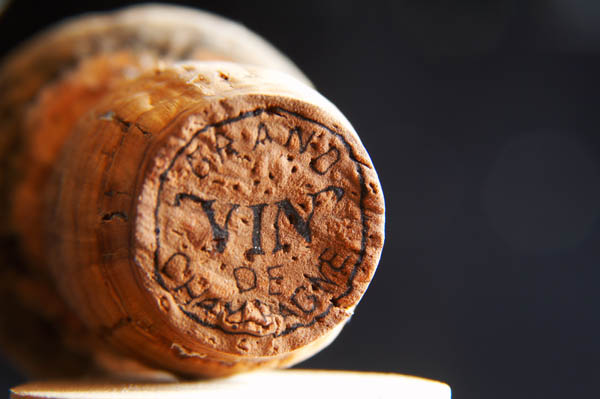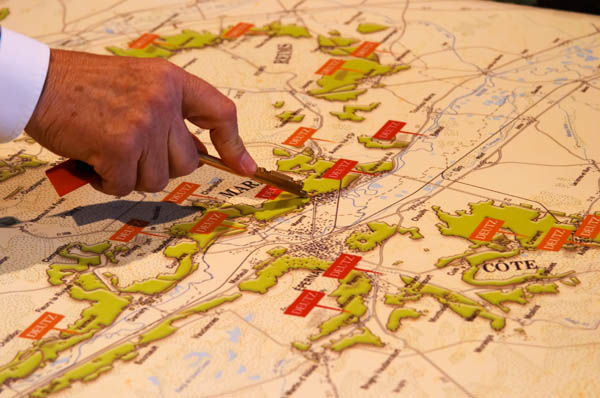Champagne is an easy two hour’s car drive east of Paris. Or you can take the fast TGV train that in just 40 minutes takes you straight into the centre of Reims, the capital of Champagne.
To give you some conversation ammunition for the festive season, here are some basic facts and figures about this famous sparkling wine region.
The Champagne region
Champagne is a region of 3s. Champagne extends over a little bit more than 33,000 hectares of vineyards. They sell a bit more than 300 million bottles each year. There are 3 main grape varieties and 3 main well-known regions (but really four, or five). Some 300 champagne “houses”.

Habitually one talks about the three grape varieties of Champagne, one white and two reds: Chardonnay, Pinot Noir and Pinot Meunier. Each has around one third of the acreage. This, however, is not quite correct. There are actually seven permitted grape varieties, but the three I just mentioned are by far the most common. The remaining four make up only some 0.3% of the total. They are Pinot Blanc, Pinot Gris, Arbanne, and Petit Meslier. All these are white.
The chalk soil in Champagne is famous and is credited with giving its character to the drink. However, there are many different soil types here, clay, sand, limestone etc, so thinking Champagne=chalk is a mistake.
The villages (communes) in Champagne are grouped in grand cru, premier cru and … just villages. This is based on the archaic échelle des crus where villages were classified according to some supposed quality. Today this is a system that should have become obsolete but unfortunately has not. It is not really a good guide to the quality of the champagne. Much more important is the name and talent of the producer.

Champagne is divided into four, or five, sub-regions:
- Montagne de Reims
- Vallée de la Marne
- Côte des Blancs
- Côte des Bar
Sézanne is a small area that is sometimes mentioned as one more sub-region of Champagne but some people consider it to be just the southern-most part of Côte des Blancs.
La Vallée de la Marne
This is the area along the river Marne, flowing east to west. It is located primarily west of Epernay towards Paris.
- 11,590 ha
- 62% Pinot Meunier
- 22% Pinot Noir
- 16% Chardonnay

Côte des Blancs
Côte des Blancs extends south from Epernay a few tens of kilometres. Here Chardonnay is the dominant, but not the only, grape. There are several famous grand cru villages: Avize, Chouilly, Cramant, Le Mesnil-sur-Oger, Oger, Oiry. However, one should not take this ”grand cru” denomination too seriously. It is not really a guarantee for quality and there are many other Champagne villages that produce wine of equal quality. What counts is the name of the producer and his skills.
- 5,610 hectares
- 82% Chardonnay
- 10% Meunier
- 8% Pinot Noir
La Côte des Bar
La Côte des Bar is the southern-most part of Champagne, close to the city of Troyes almost two hours’ drive south from Reims, in the Aube département. The climate is a little bit warmer and there is a closer kinship with Burgundy. It is not that far away from Chablis.
This little-known region produces some excellent Champagnes, often with a bit more body. This is partially due to the climate, but also the soil, and the preponderance of Pinot Noir. Sometimes it is said to be of lesser quality but that is quite unjustified. That’s perhaps what you have to suffer when you are far away from the capital and from the Big Houses.
- 8,230 ha
- 83% Pinot Noir
- 14% Chardonnay
- 3% Pinot Meunier

Montagne de Reims
Montagne de Reims is the area closest to Reims. Calling it a mountain is a bit of a stretch, but it is certainly a hill. Like the Côte des Blancs the Montagne de Reims has several grand cru villages, but again, don’t worry too much about them. There are a few villages here that are famous for their Pinot Noir, notably Bouzy and Ambonnay.
- 7,960 hectares
- 40% Pinot Noir
- 36% Pinot Meunier
- 24% Chardonnay
The sweetness, dosage
All champagne is classified according to the amount of sugar added at the end of the vinification process, the dosage at the dégorgement.
- Brut nature: 0-3 gram sugar per litre, and no sugar added
- Extra brut: 0-6 g/l
- Brut: 0-12 g/l
- Extra dry (extra sec): 12-17 g/l
- Sec: 17-32 g/l
- Demi-sec: 32-50 g/l
- Doux: 50 g/l
In other words, anything on or below 12 g/l can be called “brut”. If the wine producer so chooses he can use extra brut and brut nature, but he does not have to, he can use simply “brut”. Extra dry and sec are quite deceptive, since that indicates a champagne with a distinct sweetness.

The ageing in the bottle
The champagne has to spend a certain amount of time in the bottle before it is sold:
Non-vintage champagnes: a minimum of 15 months in the bottle. (One sometimes hears the number “18 months” quoted. This is a mistake.)
Vintage champagnes: a minimum of three years in the bottle.
Many Champagne producers keep their wines for a substantially longer time in bottle.
A large part of this time in the bottle is often on the lees from the second fermentation before the lees are removed by the dégorgement. This time on the lees is considered to give a certain character to the wine. However, it is not the time on the lees that is defined in regulations but simply the time in bottle (part of which is on the lees).

Champagne categories
There are several different “types” of Champagne:
Brut Sans Année, BSA: often referred to as “standard” champagne, “base cuvée” or similar. Or “non-vintage” for the anglophones.
Blanc de blanc: made from white grapes only, usually from Chardonnay, but it can be a blend. There are even some BdB Pinot Blanc.
Blanc de noir: made exclusive from red grapes, Pinot Noir or Pinot Meunier, or a blend thereof.
Note: most champagnes are a blend of all three main grape varieties, so blanc de noir and blanc de blanc are unusual and often a bit more expensive. BdB are usually light and mineral, BdN typically have more body and intensity.

Rosé: made from either a blend of red and white grapes or purely red grapes (this is very unusual). Rosé can be made by blending white and red wine, rosé d’assemblage (Champagne is the only wine region in Europe where this is allowed), or as rosé de saigné, where the skins are left to macerate for a short time to give just sufficient colour.
Millésimé: champagne with an indication of the vintage on the label. For the non-French literates this is sometimes referred to as “vintage”…
Cuvée prestige: A rather vague denomination for champagnes that are supposedly of higher quality, but without any real definition. Often very expensive.
[box type=”info” style=”rounded” border=”full”]Discover Champagne (the region) and champagne (the bubbly wine) on site in depth. Come on a bubbly wine tour to Champagne with BKWine.
Travel to the world’s wine regions with the experts on wine and the specialist on wine travel.
The best wine tours. BKWine wine tours.[/box]












3 Responses
how about “SEC sans Année”???
NO Basic facts and figures about Sabrage on your site!
eller gillar ni inte företeelsen??
”Sec sans année” is not an expression that is used to any extent whereas BSA is. Sec is a very small part of production.
Facts and figure on sabrage? Can’t see what “facts” or “figures”there could be about it.